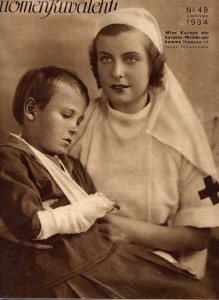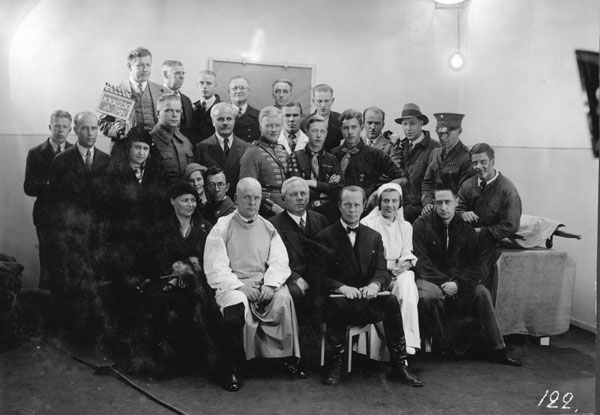
Miss Finland 1933, Ester Toivonen, as a Nurse in Meidän poikamme ilmassa
The 1930’s was decade of rising tension in Europe, and this tension was felt not only among those countries bordered by Germany but also in peaceful countries such as Finland, where the great threat was seen as being the Soviet Union. The Finnish film industry created a trilogy of “propaganda” films for the military, and this movie, Meidän poikamme ilmassa – me maassa (Our Boys in the Air) was the one that depicted the small and struggling Air Force of the Finnish nation.
Unlike the rather more entertaining movie made for the Navy, the film made for the Air Force is actually rather violent and many scenes concern civilian safety and security in cities that are being bombed from air. It’s interesting to see the predictions of how a possible future war was going to be fought, and how the civilians should be protected. Many of these predictions and precautions would turn out to be correct.
Many people will watch this movie for the aircraft – and you’ll see some unique flying scenes of aircraft from the mid-1930’s, including Gloster Gamecock and Bristol Bulldog fighter aircraft and Blackburn Ripon torpedo-bombers, Letov S218 Smolik and VL Sääski trainers. Ilmavoimat Junkers K43’s also make an appearance as the enemy bombers. There’s also some interesting casting, with Finnish singers Eugene Malmstén appearing as a construction worker and Georg Malmstén as a soloist singer in a choir. Also of note is the first appearance in a film of Miss Finland 1933, Ester Toivonen, as a civil defence nurse (named Ester).
Overall, it’s a movie worth watching from a historical perspective rather than for the film itself. It’s a good example of a rather earnest and clumsy (and let’s be honest, sometimes tedious) propaganda movie made with the best of intentions. Within the context of the period it was made in, it was a laudable attempt to prepare the population for the war with the Soviet Union that would all too soon eventuate, despite criticism from the left that it was instilling a “war-like spirit” in viewers. The film also contains ultra rare Finnish air combat scenes and at one point you glimpse Finnish aircraft sound-locator equipment and anti-aircraft guns in action. All in all an interesting and rare film that you can watch in full on youtube here.
The Plot
Yes, there is a plot woven into the scenes of aircraft. The movie begins with pilots singing “A pilot on the march.” The story then begins with an attempt by a pilot to win a new record, with a speech emphasizing the importance of such events to inspire of youth and educators, as well as civil and military pilots in the service of their country. One of the characters, Eino, undertakes pilot training and carries out military pilot qualification training. A civil inspector gives a lecture on the effects of the bombing of population centers and training in the use of gas masks.

Meidän poikamme ilmassa – some of the actors – Malmstén, Erkki Karu, Ester Toivonen, Artturi Järviluoma, Yrjö Norta, Olavi Suominen, Aarne Kajonterä, Eino Kari , Björn Soldan ja Kurt Vilja.
There is a romantic sub-plot inter-woven, with Erkki falling in love with a girl, Aino, whom hermeets again while on holiday. At the same time, another pilot, Jarmo and his mechanic, Sergeant Kalle Suula, are involved in long-distance flight competition. They are in the lead to Vyborg, but their aircraft experience’s engine failure and gasoline leakage, and they are forced to descend to a lake. They receive help from a girl, Gretel, to whom Jarma comes to have romantic feelings about.
Somewhere along the line Gretel turns out to be Erkki’s sister (I think that’s what it says). In the middle of everything a message arrives that there is a forest fire in Erkki’s home region. Air reconnaissance assistance is requested of the airforce and Erkki, Jarmo and Kalle leave for the fire area. On arrival the situation looks threatening with the house on fire. Aino (Erkki’s love interest) tells Erkki that little Mirja is missing. Erkki rushes in, and manages to save Mirja by lowering her from a window. When Erkki tries to get out through the smoke and fire, he receives a blow to his head and is left in a stupor.
While he is in a stupor he dreams that war looms: troops are concentrated at the border, population centers are issued with gas masks and evacuation of the population in the countryside takes place. Aerial surveillance warns of approaching enemy planes. Anti-aircraft positions and fighter planes are alerted, police direct people to the bomb shelters. Air Combat follows, with six enemy aircraft dropping bombs that cause great human and material damage. On the home front rescue and emergency operations begin, people are rescued from collapsed rubble and the sick and wounded are treated.
Erkki wakes up from is sickbed to find he has been delirious with fever and his doctor-father, Aino, Gretel, Jarmo and Kalle have gathered around his sickbed. He learns that Jarmo rescued him from the burning house. “Thank God, that you were just delirious with fever your dreams were not true,” his father says. – translated (probably badly) from a Finnish-language synopisis in Finland kansallisfilmografia 1 (1996) .
Press Reviews at the time
Erkki Karu’s third “….our son” movie did not get an uncontroversial positive reception at the time it was released. “Our son in the air is a propaganda film “, stated Veikko Sirviöin the Evening Times, 05/12/1934). “Erkki Karu shows what a great danger of war can threaten civilian populations from the air, and what we should do to combat this danger. The Ideology which the film portrays therefore deserves support, but the way in which we are ‘preached to’ does not. …Erkki Karu’s characters talk, talk and talk again about the threat, as if merely speaking of would these things will lead to improvements. We cannot blame the audience for getting bored with these long speeches, but what is supposed to ignite and inspire, seems washed-out and dull. This is a very tedious observation to make because we had thought that the Finnish propaganda films can do better. “
The reviewer for the Helsingin Sanomat 12.2.1934) also found a positive perspective: “This propaganda film, in which there is an actual plot adapted to couple the main character’s love story to the film, deserves full recognition of the photography. …. The aircraft offers great potential for the camera, and these resources have been utilized. Glossy steel birds against white clouds make an enjoyable feast for the eyes, and the possibility exists of this film being compared the best of American air film achievements. ”
JO Tallqvist in the Swedish Press, (04.12.1934) wrote that “Mr Karu’s new movie, Our boys in the Air – propagates the science of protection against aerial-bombing. ……The results nevertheless make an extremely clumsy and sad impression, which not even the truly beautiful aerial photographs, the only enjoyable part of the film, offset. The purpose is conveyed with objective and scientific instructional scenes, together with lots of drama as Karu tried to jazz up the film with the addition of romance and excitement, a laudable attempt.”
A further review represented perhaps the most positive attitude (3/12/1934): “In creating Our Boys in the Air, Erkki Karu has built on solid patriotic foundation in the best traditions of the Finnish film industry. The film is uplifting and educational, emphasizing an explicitly patriotic spirit and it is certain that the film will continue to have value and significance. ……. Even though Our Boys in the Air has been specifically designed as propaganda, perhaps more strongly than the previous two military films….. …..the director has cleverly combined a propaganda film with an actual storyline, overlapping each other….. “
An opposite line was taken by the left-wing Finnish Social Democratic (12/02/1934): “There’s nothing particularly nationalistic in this movie, with the exception of the national landscape and of course the actors. ….. it has contributed to …. preparing the ground for stirring up and maintaining a war-like spirit. This propaganda is, of course, recognized policy…. “
The Director – Erkki Karu
The director of this movie, as for the previous two “Our Boy” propaganda movies (“Our Boy” – about the Army, and “Our Boy at Sea” – about the Navy), was Erkki Karu. The film was reasonably well received at the time, with the idealization of the military and the portrayal of the effects of aerial bombing on civilians reflecting the mood of the period.
 Copyright secured by Digiprove © 2013 Alternative Finland
Copyright secured by Digiprove © 2013 Alternative Finland


